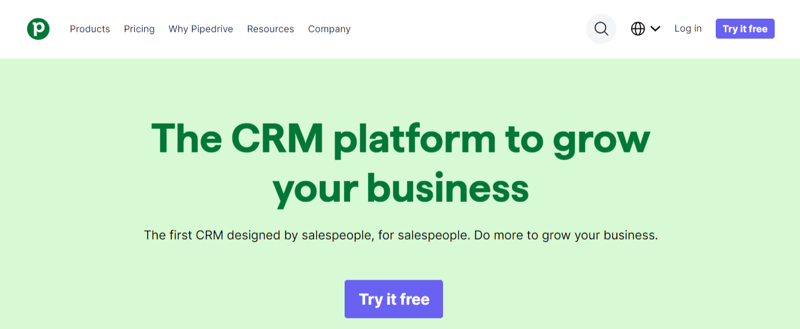
7 Sales and Operations Planning Strategies That You Can Actually Implement
 Updated on
Updated on
 By Robins Dorvil
By Robins Dorvil
Robins Dorvil
With over 7 years of experience in the insurance industry, 4+ years as an Account Executive at Ringy CRM, and 17 years as a Creative Real Estate Inves...
learn more
Robins Dorvil
With over 7 years of experience in the insurance industry, 4+ years as an Account Executive at Ringy CRM, and 17 years as a Creative Real Estate Inves...
Table of Contents
Table of Contents
Ah, you've hit a roadblock.
We understand the feeling.
Your company is increasing in size, but the different departments seem to be operating independently of each other, and the headaches won't end, right?
There's a reason for concern. If an engine doesn't work on all cylinders, it doesn't work. And the same is true of companies.
You have to find a way to get everybody in the company on the same page, and fast, because while you're trying to tame the chaos, your competitors are zooming past you like this:
But not to worry. If you're looking to improve your company's sales and operations planning, you've begun the right way.
In this article, you'll learn:
- What is Sales Operations Planning?
- Sales and Operations Planning Process
- 7 Easy to Implement Sales Operations Planning Strategies
- 5 Types of Software to Help with Sales Strategies and Operations
- Top 4 Sales CRM in Today's Market
What is Sales and Operations Planning?
Sales and operations planning first emerged in the 1980s when companies realized that letting every department do its own thing wasn't exactly a recipe for success. Sales, marketing, finance, and production were all speaking different languages—and not in a charming, cosmopolitan way.
Before sales and operations planning, businesses were plagued by disconnected strategies and surprise inventory issues. But someone (give that person a raise) thought: what if we actually got all the departments in the same room?
Now, zoom in a bit.
Sales and operations planning is the solution—an integrated business planning process that unifies forecasts, production, and financial goals. It aligns supply with demand and turns wild guesses into calculated decisions.
That said, modern sales teams can't afford to wing it. You need a sales operations strategy that bridges the gap between high-level vision and boots-on-the-ground execution.
Sales strategy roles define what you want to achieve. Sales operations roles figure out how to make it happen—on time, on budget, and without chaos.
That's why sales and operations planning brings so much value. It forces strategy and operations to hold hands, share data, and align on what's actually possible. Otherwise, your sales goals might just be wishful thinking in a spreadsheet.
There's also a direct link between sales strategy roles and operations planning. Strategy outlines what the business wants to achieve; operations figure out how to make it happen.
Planning connects the two—ensuring that goals are realistic, resources are aligned, and execution is measured. When these roles work together, sales becomes less reactive and more proactive, with better outcomes and fewer surprises.
Sales and Operations Planning Process

Quite some time has passed since the 1980s, and so inevitably, companies have begun to standardize the steps they take during the sales and operations planning process.
Though each company might do it a little bit differently, the process usually consists of five steps.
1. Data Gathering
The first step is acquiring the data from the previous sales cycles in an attempt to accurately forecast the future. As mentioned above, providing planners with enough data is crucial, or the process will grind to a halt before it even has the chance to get started.
If the planners have the data they need, they can assess industry trends during this step, along with information from previous sales. They will use the information to make future predictions.
Essentially, during this stage of sales and operations planning, companies must bring to bear all the information they have at their disposal in order to predict the direction the company should take in the future.
Think of sales and operations planners like snipers. If you don't tell them the speed of the wind, the humidity, and all the other information snipers need, then you don't even bother taking the shot. You'll never hit the target.
2. Demand Planning
The plans and adjustments during this step reflect the data and conclusions gathered in the data-gathering step. This step requires collaboration between the various departments.
Sales, marketing, manufacturing, and customer service must come together to review inventory levels, adjust marketing and sales strategies, and customer service policies.
Market trends also come into question, as well as financial planning, as the company leadership must decide how to use its resources to maximize the company's potential.
3. Production Planning
During this step, the company management will review every part of the production process to determine if it matches their needs.
Manpower, machinery, and the number of suppliers are all reviewed. Will the company produce enough? Will it produce too much? What is the supply-chain timeline, and does it match the company's sales timeline?
All these questions must be answered during production planning in order to ensure the company does not suffer logistical setbacks. Overproducing is always a threat, which is why sales and operations planning is crucial when it comes to shortening the cash-to-cash cycle.
4. Financial Review

During this step, the CFO of the company and the other departments must get on the same page.
The aim is to synchronize the sales and operations planning with the company's financial considerations.
What are the revenue projections, the plan of replenishment, and will the cash flow of the company be sufficient during the execution of the plan?
If the previous steps are about charting the plan for the future, this step is about ensuring the company can afford it.
5. Finalizing and Implementing the Plan
Once all the departments have had their say and their perspectives have been incorporated into the plan, it is time to implement it.
As it is executed, the plan is monitored for effectiveness and profitability. Companies must consistently review the accuracy of their plans and question the decision-making process behind those plans if they wish to improve the overall performance of their planning in the future.
7 Easy to Implement Sales and Operations Planning Strategies
Sales and operations planning is a complex process that comes with its fair share of pitfalls. Getting it wrong means logistical bottlenecks, the inability to meet the demands of the market, and a lot of lost revenue.
That's why companies should do everything in their power to make their planning as reliable and accurate as possible.
Here are 7 strategies that can help.
1. Align Sales Goals with Business Objectives
It sounds obvious, but too often, sales teams chase metrics that don't move the business forward. The key is aligning sales operations goals with the company's broader KPIs—from revenue targets to customer lifetime value.
When sales goals are set in isolation, reps might hit their numbers while the business still misses its targets. That's a misfire waiting to happen.
Through system analytics, your company gets first-hand insight into your company's performance and market trends. CRMs are a great way to compile data in the same place and ensure every single one of your employees is looking at the same picture.
At any given moment, all your employees will know about the sizes of your deals and how far along the sales process they have gone, letting everyone know where the business is going and what the needs of the customers, as well as the company, are.
By managing all these processes from a single platform, CRMs, like Ringy, become an invaluable tool when it comes to sales and operations planning.
2. Standardize Sales Processes

Inconsistent sales methods create bottlenecks, training headaches, and customer confusion. Standardizing sales processes not only boosts efficiency but makes it easier to scale.
Sales operations teams should document the ideal customer journey, define every sales stage clearly, and use automation tools to keep things flowing.
Tools like Ringy help streamline efforts with workflow automation, auto-dialers, and smart CRMs. The result? Reps spend less time on admin and more time selling.
Standardized processes also make onboarding smoother. New reps can hit the ground running instead of figuring out how things might work.
3. Create a Centralized Data System
Here's the thing. Messy, fragmented data is the enemy of good planning. For sales strategy and operations to succeed, teams need a single source of truth.
That means integrating sales tools, CRMs, and marketing platforms into one centralized, clean system. When everyone, from sales reps to executives, is working with the same data, forecasting becomes accurate, and decision-making gets faster.
A McKinsey study showed that 83% of sales executives say their data is siloed across systems. That's a lot of lost insights and missed opportunities.
The fix? Invest in data hygiene, adopt integrations that eliminate duplicate entry, and make data access intuitive for your team.
4. Automate Repetitive Sales Tasks
Your reps didn't get into sales to log activities manually or chase follow-ups. Sales operations planning should include identifying every repeatable task that can be automated.
Start with:
- Lead scoring
- Email follow-ups
- Meeting scheduling
- Pipeline updates
AI tools and CRMs can handle all of this without blinking. According to McKinsey, automation can save sales teams up to 30% of their time—and that time can be redirected toward relationship building and closing deals.
Bonus: Automation also reduces human error, which means cleaner reporting and fewer headaches later.
5. Optimize Sales Forecasting Techniques
If your forecasts are mostly guesswork and crossed fingers, it's time for an upgrade.
Modern sales operations roles are embracing AI-powered forecasting tools and combining them with historical data to predict revenue with precision. These tools can flag risk early, uncover trends, and support better planning across departments.
Companies that use data-driven forecasting can experience 10% higher forecast accuracy and 10-15% reduction in costs, according to McKinsey.
The takeaway? Smarter forecasting means fewer surprises and more consistent performance.
6. Prioritize Sales Enablement and Training
You can't expect reps to succeed with outdated playbooks or unclear expectations.
Investing in sales enablement and training helps both new hires and seasoned reps stay sharp and aligned.
Sales operations should lead the charge in:
- Creating onboarding workflows
- Offering just-in-time learning content
- Equipping teams with updated sales collateral and objection-handling tools
Empowering both sales strategy roles and frontline reps makes everyone more effective. And companies that prioritize enablement see 49% higher win rates.
7. Foster Collaboration Between Sales and Other Departments
Sales and operations management can't live in a vacuum. For real results, sales teams must collaborate with marketing, product, finance, and customer success.
Whether it's syncing on lead quality, pricing updates, or feedback loops, cross-functional alignment helps eliminate friction and drive better outcomes.
Sales operations plays a key role here, breaking down silos and creating shared systems, shared goals, and shared wins.
Companies with strong sales and marketing alignment see 20.3% increase in win rates from marketing efforts, according to HubSpot.
Each of these strategies is doable, impactful, and rooted in helping your sales team work smarter, not harder. Build them into your sales operations planning process, and you'll create a more agile, efficient, and scalable sales machine.
5 Types of Software to Help with Sales Strategy and Operations
Great sales results don't happen by accident, they're built on solid planning and the right tools.
Whether you're fine-tuning a quarterly sales strategy or overhauling your entire sales operations planning process, these five types of software are your secret weapons for smoother execution and smarter decisions.
1. Sales CRM
A customer relationship management system can offer indispensable benefits to companies during their sales and operations planning process.
A CRM system like Ringy provides management with an overview of the entire customer journey, which has proven to have an incredible effect. A study found that 63% of companies with the highest annual growth in terms of sales revenue used a CRM.
The overview of the entire process allows companies to discover areas that need improving, and the insights provided by the analytics give them a thorough understanding of market trends and make it easier to predict how the market will behave moving forward.
And by centralizing all the information within one system, companies can ensure every employee and every department has access to the same data.
2. Business Intelligence Tools

Business intelligence (BI) tools are all about helping businesses understand trends and interpreting data in a way that ensures companies can make informed strategic decisions. They exist for the sole purpose of analyzing past, present, and future data with the goal of producing actionable insights.
Data discovery, a process that required advanced analytics specialists once upon a time, is now available to anyone with the use of these tools.
Companies can use them to forecast market outcomes.
Business intelligence tools boast comprehensive reporting capabilities and interactive data visualizations. Many of these tools offer self-service analytics, meaning all levels of users have access to every feature these tools offer, without the need for specialized technical skills.
Business intelligence tools also aim to get rid of manual tasks. While a lot of businesses still rely on spreadsheets, business intelligence tools automate the process by, for example, constantly updating the key performance indicator dashboard.
3. Supply Chain Management Cloud
Supply chain management clouds were designed to digitize the supply chain to achieve greater efficiency and streamline every aspect of your inbound and outbound supply chain.
These cloud-based operations aim to provide end-to-end business processes, with the changing nature of the supply chain in mind.
Supply chain management clouds are needed because companies have to reimagine how they go about planning their logistics. They need to shift from linear supply chain models to digital supply chain networks.
All this has to be done with increased efficiency and lower costs in mind because companies need to achieve both if they mean to contend in the increasingly competitive international market.
Cloud management can help companies revolutionize every aspect of their supply chain process, from manufacturing and sourcing to distribution.
Supply chain management clouds can enable visible and scalable supply chains and are more flexible in the face of unexpected developments.
4. ERP Software
The acronym stands for Enterprise Resource Planning. But what does that mean, exactly?
The name refers to a type of software that companies rely on for day-to-day business activities. Accounting, project management, compliance, and supply chain management all fall under this umbrella.
The software can also be used for any stage of a company's financial planning processes, from planning to budgeting to analyzing end results. And though financial planning is a large part of ERP software, the features encompass every part of sales and operations planning.
ERP systems all revolve around one data structure with a common database, which fuels collaborations as users get to share data. The systems reduce risk as they offer financial controls.
5. Sales Forecasting Tools
As you should already know by now, guessing is not a strategy. Sales forecasting tools take the guesswork out of planning by analyzing historical data, pipeline trends, and market signals to predict future performance.
For sales operations roles, these tools are gold. They help you set realistic quotas, identify risks early, and course-correct before things go off the rails.
Many tools now use AI and machine learning to improve forecast accuracy over time. Think Gong Forecast, Clari, or InsightSquared.
Sales forecasting tools aren't just about predicting revenue, they're about empowering better decisions across the board.
Whether you're building your first sales operations strategy or refining an existing one, these software categories will strengthen your planning, execution, and team performance. Invest wisely, connect your systems, and let the data do the heavy lifting.
Top 4 Sales CRM in Today's Market
*Note: All pricing details are accurate as of May 2025*
1. Ringy

Ringy is a cloud-based CRM designed to streamline sales and marketing processes. It offers tools for lead management, communication, and automation, making it suitable for businesses aiming to enhance their sales operations.
Key Features:
- Lead Management: Organize and track leads efficiently.
- Communication Tools: Integrated calling and texting features.
- Automation: Automate follow-ups and workflows.
- Reporting: Gain insights into sales performance.
Pricing: Ringy offers a subscription plan at $109 per month, plus the cost of additional credits.
And when it comes to the customer experience, you can examine some of the reviews here.
2. Salesforce

Salesforce is a leading CRM platform known for its extensive customization and integration capabilities. It supports businesses in managing customer relationships, sales processes, and marketing campaigns.
Key Features:
- Customizable Dashboards: Tailor views to monitor key metrics.
- Integration: Connect with various business tools and applications.
- Automation: Automate sales and marketing workflows.
- AI-Powered Insights: Utilize AI for predictive analytics and recommendations.
You can check out some of their reviews here.
Pricing: Salesforce offers various CRM solutions plans, as shown below:
|
Plan |
Price |
|
Starter Suite |
$25/month per user |
|
Pro Suite |
$100/month per user |
|
Enterprise |
$150/month per user |
|
Unlimited |
$330/month per user |
|
Einstein 1 Sales |
$500/month per user |
3. Hubspot

HubSpot provides a user-friendly CRM platform that integrates marketing, sales, and customer service tools. It's suitable for businesses seeking an all-in-one solution to manage customer interactions and growth strategies.
Key Features:
- Contact Management: Maintain detailed records of customer interactions.
- Email Marketing: Create and track email campaigns.
- Sales Pipeline: Visualize and manage sales processes.
- Automation: Automate repetitive tasks and workflows.
Hubspot CRM offers companies a great way to not only streamline their business processes but also gain insight into them, providing far greater clarity in their sales and operations planning.
You can check out what their customers have to say about their services here.
Pricing: HubSpot offers a free CRM with basic features. Paid plans with advanced functionalities cost as follows:
|
Plan |
Price |
|
Marketing Hub Starter |
US$15/month/seat (paid annually) |
|
Starter Customer Platform |
US$15/month (paid annually) |
|
Marketing Hub Professional |
US$800/month (paid annually and includes 3 seats) |
4. Pipedrive

Pipedrive is a deal-driven CRM system that also works as an account management system, used by over 100,000 sales teams worldwide. The features they offer their customers include:
Key Features:
- Visual Sales Pipeline: Track deals through customizable stages.
- Automation: Automate tasks like follow-ups and data entry.
- Reporting: Access insights into sales performance.
- Integrations: Connect with various apps and services.
Combining a CRM system with account management makes Pipedrive a great asset for any company looking to gain better insight into their business processes while managing their operations from a single platform.
Customers often complain that Pipedrive doesn't offer ‘true' email automation, and the workflow automation only allows for one trigger at a time. You can check out more about what customers have to say here.
Pricing: Pipedrive offers four different pricing plans:
|
Plan |
Price |
|
Essential |
$14/month per user (Billed annually) |
|
Advanced |
$39/month per user (Billed annually) |
|
Professional |
$49/month per user (Billed annually) |
|
Power |
$64/month per user (Billed annually) |
|
Enterprise |
$99/month per user (Billed annually) |
FAQs
"What is the goal of sales and operations planning?"
The goal is simple: balance.
The objective of the entire process is to bring all the processes within a company on the same page. Marketing must reflect sales plans. The distribution must reflect the plans of manufacturing. And every part of the process must be in line with the financial aspect of the business.
By achieving this balance, companies ensure their operations are running on all cylinders, with no resources wasted and no opportunities missed.
"What is the relationship between sales and operations planning?"
In essence, by combining sales with operations, you are providing your operations with much-needed data.
For example, manufacturing can focus on producing as much as possible within the constraints of its resources. But by establishing solid communication with sales, manufacturers are made aware of market trends and demands, allowing them to channel their resources in a way that maximizes the company's bottom line.
"What is the difference between sales and sales operations?"
Sales operations are the process of figuring out the logistics and planning for the team moving forward. Sales itself is the execution of those plans.
Sales operations handle the hiring and training of new sales reps, determining the strategy, and optimizing the sales process.
Sales itself is then placed in charge of putting those plans into action and taking advantage of the tools sales operations provide.
Sales and Operations Planning Can Get Easier
So we've established in this article that sales and operations planning is no joke. It is a process that must be handled carefully and diligently. The executive branch of the company must be all-in on it in order to provide the planners with all the data and tools they need to make accurate predictions.
Sales and operations planning can help companies become more flexible and prepared for unexpected changes. It is a form of future-proofing their business operations. It can help:
- Streamline processes
- Lower costs
- Channel resources in the direction that will offer maximum returns
It's a no-brainer. Even though some companies believe they can continue with what they consider ordered chaos, the weaknesses in that approach will become patently clear with time.
And on that day, they will see their competition leave them in the dust as they scoop up their market share and fly off toward a brighter tomorrow.
So don't hesitate to get busy and work toward improving your sales and operations planning today. Contact Ringy today to learn more about how you can take your business to the next level.

Skyrocket your sales with the CRM that does it all.
Calling? Check. SMS? Check. Automation and AI? Check. Effortlessly keep in touch with your customers and boost your revenue without limits.

Take your sales to new heights with Ringy.
Sales in a slump? Ringy gives you the tools and flexibility you need to capture leads, engage with them, and turn them into customers.
Subscribe to Our Blog
Enter your email to get the latest updates sent straight to your inbox!
Categories
Related Articles
























































































